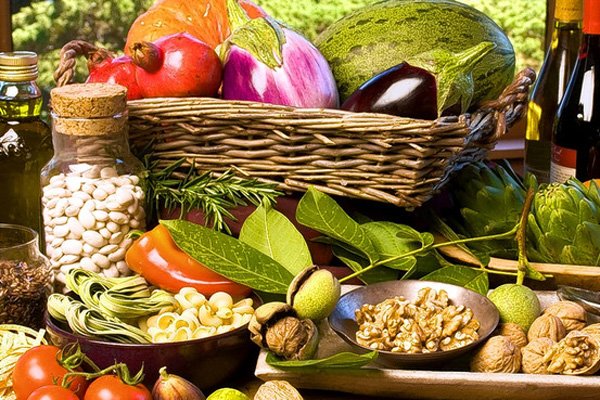
Sure they’re high in fat, but avocados contain healthful monounsaturated fat, which has been linked to a reduced risk of cancer, heart disease, and diabetes. “Avocados aid in blood and tissue regeneration, stabilize blood sugar, and are excellent for heart disorders,” says Ed Bauman, Ph.D., director of Bauman College . They’re loaded with fiber (11 to 17 grams per fruit) and are a good source of lutein, an antioxidant linked to eye and skin health.

“An apple a day really does keep the doctor away,” says Jonny Bowden, Ph.D., C.N.S., author of The 150 Healthiest Foods on Earth. Apples are loaded with the powerful antioxidants quercetin and catechin, which protect cells from damage – that means a reduced risk of cancer and cardiovascular disease, especially if you eat the skin. Research shows that the apple peel contains five times more polyphenols than the flesh. Apples and their skins pack a lot of fiber too (about twice that of other common fruits, including peaches, grapes, and grapefruit), which may help fight the battle of the bulge.

Antiaging superstars, blueberries are loaded with antioxidants, especially anthocyanins, which have been shown to improve vision and brain function. Studies show that eating blueberries slows impairments in motor coordination and memory that accompany aging. These little berries also reduce inflammation, which is inextricably linked with virtually every chronic disease from Alzheimer’s and Parkinson’s, to diabetes and heart disease. Other studies show that blueberries have much greater anticancer activity than other fruits.

In the vegetable world, the Brassica genus reigns supreme, and the cabbage is the most impressive of the lot. Brassica vegetables (including broccoli, bok choy) contain compounds called indoles, which have been shown to reduce the risk of cancer dramatically. “Eating cabbage more than once a week cut men’s colon cancer odds by 66 percent,” says Bauman. “Cabbage also stimulates the immune system, kills bacteria and viruses, and is a good blood purifier.” If you go for the red variety, you’ll also get a healthy dose of anthocyanins (the same pigment molecules that make blueberries blue), another powerful antioxidant with an anticancer punch.

Eating fish helps cut the risk of heart disease, cancer, Alzheimer’s, stroke, diabetes, and arthritis. The fatty varieties may also help alleviate depression. The American Heart Association recommends that adults eat at least two fish meals per week, especially wild salmon, herring, and sardines, because those varieties provide the most heart-healthy omega 3s. Avoid mercury-containing varieties like shark, swordfish, king mackerel, tilefish, and albacore tuna, says Roberta Anding, M.S., R.D., national spokesperson for the American Dietetic Association.

Research shows that garlic lowers total cholesterol and triglyceride (blood fat) levels, helping prevent clogged arteries. “Two to three cloves a day cut the odds of subsequent heart attacks in half for heart disease patients,” says Bauman. “Garlic also tops the National Cancer Institute’s list of potential cancer-preventive foods.” Whole baked garlic helps detoxify the body of heavy metals like mercury (from fish) and cadmium. Garlic also acts as an antibacterial and antiviral, boosting resistance to stress-induced colds and infections. Can’t stand garlic breath? Chew on a sprig of parsley.

Used for centuries in Eastern medicine, mushrooms have powerful effects on the immune system – especially the maitake, shiitake, and reishi varieties. “Mushrooms such as maitake help prevent and treat cancer, viral diseases, high cholesterol, and high blood pressure,” says Bauman. In fact, mushrooms are used as an adjunctive cancer treatment throughout Asia because of their ability to counteract the toxic effects of chemotherapy and radiation while simultaneously shrinking tumors. What’s more, Japanese researchers have found that regularly eating shiitake mushrooms lowers blood cholesterol levels up to 45 percent.

Almonds are loaded with fiber and monounsaturated fat, both of which have been shown to lower cholesterol. According to the Food and Drug Administration, eating 1.5 ounces of most nuts, including almonds, as part of a diet low in saturated fat and cholesterol may reduce the risk of heart disease. And even though almonds are relatively high in fat and calories, studies show that eating almonds can actually help with weight loss (their protein, fiber, and monounsaturated fats provide the feeling of fullness, preventing overeating).

The best protein source on the planet, eggs consistently outrank milk, beef, whey, and soy in the quality of protein they provide. In addition to containing all nine essential amino acids, eggs are loaded with nutrients. “And for God’s sake, eat the yolks,” says Bowden. People avoid the yolks because they fear cholesterol, but egg yolks contain choline, which helps protect heart and brain function and prevents cholesterol and fat from accumulating in the liver.

Loaded with alpha-linolenic acid, an essential fatty acid that helps reduce inflammation, flaxseed has been used for centuries for medicinal and health reasons. Gandhi himself proclaimed, “Wherever flaxseed becomes a regular food item among the people, there will be better health.” Bauman adds, “The seed itself has terrific nutritional value, very usable protein, tremendous fatty acids, and minerals like magnesium, potassium, and zinc.” Additionally, they’re a great source of fiber.

Pomegranates have up to three times the antioxidants of red wine and green tea – and the juice has been shown to reduce artery-clogging plaque, which in turn prevents heart disease and stroke. Research shows that long-term consumption of pomegranate juice may also help slow aging and protect against cancer.

A small amount of any kind of alcohol each day does your heart good by increasing HDL cholesterol and reducing the risk of blood clots. “Red wine also contains powerful antioxidants, reservatrol and saponins, which may provide additional cardiovascular benefits,” says Anding. Resist a refill, however: More than one drink daily has been linked to high blood pressure.

When it comes to chocolate, bitter is better – at least in terms of health. The benefits of chocolate come from flavonols and antioxidants (the same disease-fighting chemicals found in cranberries, apples, strawberries, and red wine). The caveat: Only real cacao contains flavonols, so look for chocolate that boasts a high percentage of cacao (60 percent or more). Dark chocolate also has fewer calories than other varieties, and when eaten in moderation, it lowers unhealthy LDL cholesterol and prevents plaque from building up in your arteries.



